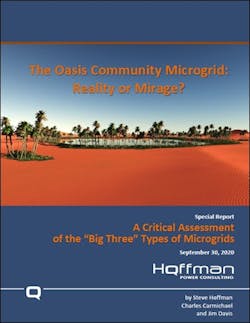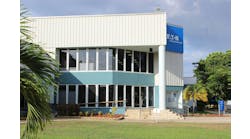Microgrid use has been on the rise for decades among commercial energy users, as well as universities, military bases, public facilities and more.
Get the full report.
These efforts have served to cut down on electrical power costs, ramped up decarbonization efforts and increased power reliability and quality. That’s according to a new report from Hoffman Power Consulting. And now, microgrids are serving to enhance electric power resilience, as well.
This is becoming increasingly important due to the higher frequency of wildfires and extreme weather – and the threat of cybersecurity and other attacks on the electric power infrastructure, which have “have motivated utilities, communities, and energy users to enhance the resilience of electric power systems,” says the report. “As a result, these stakeholders have implemented various resilience solutions, including microgrids.”
One type of microgrid that is on the rise is the community microgrid. Hoffman’s new report discusses a certain type of community microgrid — the oasis microgrid.
According to the report, they act as a centrally-located refuge, or an “oasis” for community residents during extreme events.
“While single-customer microgrids enhance resilience for a single entity, an oasis community microgrid can keep electricity flowing across multiple customers and broader areas, thereby increasing the resilience of the local community.” — Hoffman Power Consulting
These oasis community microgrids may be few and far between today, but they have proven their resilience and decarbonizing capabilities, among other benefits.
According to the report, an oasis community microgrid has the potential to provide the following additional benefits to communities and utilities:
- Demonstrates feasibility and value
- Fosters understanding, awareness and cooperation
- Generates revenue
- Benefits the macrogrid
- Enhances economic security
- Promotes social and racial equity
But challenges remain. Legal, regulatory, institutional and financial barriers in some jurisdictions complicate widespread growth of community microgrids.
The report details the community microgrid market opportunity, market drivers, business models, benefits/value, barriers to implementation (and recommended solutions), prototype installations, and recent regulatory/legislative activity.
Hoffman Power Consulting also delves into insights from COVID-19 regional and local health, safety, and economic impacts that may strengthen the case for community microgrids.
Download the full report, “A Critical Assessment of the ‘Big Three’ Types of Microgrids,” to further explore the potential of oasis community microgrids.







